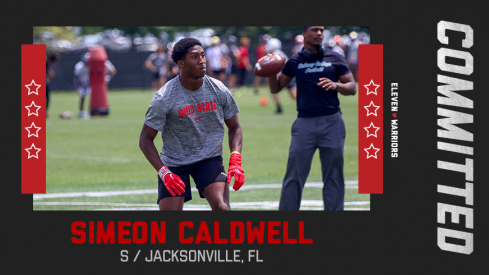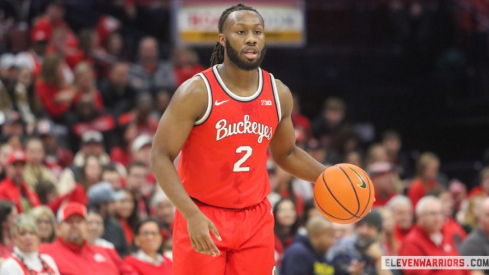Ohio State adds another top-100 safety as Simeon Caldwell commits to the Buckeyes.
Eight years ago, the NBA’s risk-prone owners and reluctant players association agreed to change the draft’s eligibility rules.
 We can thank the NBA for forcing Greg Oden on us. Thanks!
We can thank the NBA for forcing Greg Oden on us. Thanks! With the ratified collective bargaining agreement in place, the new eligibility rules went into effect for the 2006 draft. The requirements stated that players must be at least 19 years old and – for U.S. born players – one year removed the graduation of their high school class.
Players aren’t forced to go to college – as evidenced by Brandon Jennings' one year in Italy – but it’s clearly the most convenient route to the professional ranks. For better or worse, the elite high school prospects are potentially penalized by not being able to enter the NBA immediately.
At the same time, some of those athletes bolstered their draft stock with dominant performances at the college level.
The following athletes were ranked number one in their recruiting class by at least one scouting service, and were drafted by NBA teams following their college careers:
2006 – Greg Oden
Greg Oden was the consensus number one recruit by both Scout and Rivals in 2006.
 Dominant on both ends versus Florida
Dominant on both ends versus FloridaFrom the moment he stepped on the Ohio State campus, he was hampered by injuries. His right wrist injury proved to be a blessing, however. It helped him develop his left-handed game, with added touch around the rim and at the free-throw line.
Once he was more noticeably healthy, Oden gained more consistency. He scored in double figures in 13 consecutive games during February and March. A defensive force from the beginning, he quickly matured into a dominant post presence on both ends.
His most well rounded performance was during the title game against Florida, against future all-stars Joakim Noah and Al Horford. He dropped 25 points on 10-15 from the field, blocked four shots and pulled in 12 boards.
It cemented his number one overall status, as he ended going to the Portland Trail Blazers ahead of Kevin Durant. At the time, it was a safe pick and was hailed as part of a renaissance for the city.
We all know what happened from there.
The knee injuries piled up, and he only played in 82 total games in his Blazers career (surprisingly high, actually). Still, he’s only 25 years old and drawing interest from the Miami Heat and Cleveland Cavaliers
2007 – O.j. mayo
Highly touted throughout his young career in Ashland, Ky. (he played on the high school varsity squad as a seventh grader), North College Hill near Cincinnati, and at Huntington High School, O.J. Mayo was Scout’s number one overall recruit.
 Mayo, well-known since 7th grade
Mayo, well-known since 7th grade Before LeBron James even graduated high school, Mayo received the honor of being compared to him. Despite all the hype surrounding Mayo, he was not the clear top recruit in 2007. For example, Rivals ranked Michael Beasley, Eric Gordon and Derrick Rose ahead of him.
Mayo had, the most star power, however, fitting in at Southern California. He wasn’t overly dominant, but did make the All-Pac-10 first team, averaging 20.7 points per game and 40.9-percent from three-point range.
He was drafted third overall by the Minnesota Timberwolves, who made a rare, wise draft-day move by trading him for Kevin Love (among others). He hasn’t developed into a perennial all-star, but he is a solid scorer. Question with him has always been his all-around effort, but that won’t stop him from cashing a huge check this summer, as an unrestricted free agent.
2008 – Byron Mullens
In hindsight, this will surprise anyone: Byron (then known as B.J.) Mullens was Rivals’ number one overall recruit coming out of Canal Winchester.
 Byron shed the B.J. label from OSU
Byron shed the B.J. label from OSUTo be fair, he landed on a largely inexperienced team, with no true point guard. To be unfair, the transition proved to be more difficult for him than any other recruit on this list.
It’s not like Thad Matta coddled him, though.
Mullens, as is the case in the NBA, was forced to earn his minutes. They weren’t plentiful, especially early in the 2008-09 season. He rarely earned the chance to start, too, only doing so twice in his 33 games.
So, Mullens carved a comfortable role for himself by coming off the bench. During conference play in January, he averaged 11.1 points per game – not an easy task during his first month in a physically demanding conference.
He earned the Big Ten’s Sixth Man of the Year Award, a nice feat for a guy who struggled with consistency. On the season, he averaged 8.8 points per game on 64-percent shooting.
He showed flashes of range on his jumper and the ability to run the floor. Had he stayed past his freshman year, he might have lived up to his five-star billing.
Mullens, instead, declared for the NBA Draft, and was selected by the Dallas Mavericks with the 24th overall pick. They immediately shipped him to Oklahoma City. He rode the bench for the Thunder for two years before being sent to Charlotte.
This past season, Mullens started to show signs of being a productive NBA player – a seldom-used description for a member of the Bobcats. He shot a gaudy 38-percent from the field, but had eight double-doubles (plus, this sick dunk over all-star forward LaMarcus Aldridge).
2009 – john wall
He wasn’t considered the surefire top recruit, but John Wall was number one according to Rivals.
By the time Wall left Kentucky, there was no doubt that he was the best player in his class. Had he been able to jump to the NBA immediately, he would’ve entered with little fanfare and no music video showcasing his dance moves.
Since Derrick Rose, John Calipari has coached some incredible point guard talent. His dribble-drive motion offense was perfect for Wall, who was an immediate sensation. In his first 12 games, he averaged 17.9 points and 6.4 assists per game.
He, along with DeMarcus Cousins, led Kentucky to a 35-3 record and an appearance in the Elite Eight. Those efforts earned him National Player of the Year honors from Foxsports.com and CBSSports.com (the real hardware went to Evan Turner, of course).
Wall was drafted by the Washington Wizards with the number one pick, and has become an easy target for critics, even several years after leaving Kentucky.
2010 – Harrison barnes
 Barnes looks like he'll have a fruitful NBA career
Barnes looks like he'll have a fruitful NBA career Harrison was the number one recruit, according to multiple recruiting services, and was so overwhelmingly hyped, that the AP named him a pre-season All-American – the first freshman ever to receive that honor.
Worth repeating: not Freshman All-American – the All-American team for everyone.
He was considered as one of the best shooters to come out of high school in a while, perfect for Roy Williams to mold. With such great expectations, came great pressure, and, although Barnes was solid, he was not first-team All-American worthy.
For his Tar Heel career, Barnes hit 34.9-percent of his threes, a number that he eclipsed in his first NBA season. He struggled to create his own shot for much of college, but still managed to set ACC freshman-scoring records and become the top scoring threat on a team that would win a regular season conference title in his two years at Chapel Hill.
After his sophomore year, the Warriors made Barnes the 7th overall pick in the 2012 draft, a perfect fit for a group that scared the Spurs in this past season's playoffs.
He may not have lived up to his enormous, ridiculous expectations, but he might just be more suited for the NBA – alongside Stephen Curry and Klay Thompson, in particular.
2011 – Anthony Davis
According to Scout , 247Sports and ESPN, Anthony Davis was the top recruit in the class of 2011.
It was part of another recruiting coup from Calipari’s Kentucky staff, which surrounded Davis with Michael Kidd-Gilchrist and Marquis Teague.
This all goes down in Big Blue Nation lore as one of their most talented teams. Having personally witnessed their appearance in the Final Four, their team was as dominant as advertised.
Davis was the catalyst. A lanky, 6-foot-10-inch forward with a 7-4 wingspan and guard-like mobility, Davis was undoubtedly going to be the Hornets (now Pelicans) pick.
Sure, he’s lacking in post-up ability but he was the most tantalizing defensive prospect to come along since Oden. He led a suffocating Wildcats defense with 4.7 blocks per game, and – when healthy – has the potential to be a premier shot blocker in the NBA.
Nerlens Noel was the consensus top recruit in 2012. As of this post, he is being considered by the Cleveland Cavaliers for the number one pick in the 2013 NBA Draft. If not for a torn ACL, Noel might be the undisputed choice.

